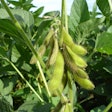
The U.S. Department of Agriculture (USDA) has released its latest crop production forecasts for 2024, presenting a nuanced picture of agricultural trends and potential shifts in the market landscape for major U.S. crops.
Corn production trends
Corn, a staple in U.S. agriculture, is expected to see a slight decrease in production for 2024. The USDA forecasts total corn production at 15.1 billion bushels, down 1% from the previous year. Despite this decline, the projected output remains the third highest in U.S. history. A significant factor contributing to this near-record production is the anticipated yield of 183.1 bushels per acre, which would set a new record high, surpassing last year's final estimate by 5.8 bushels. This increase comes even as the total planted area has decreased by 4% year-over-year to 90.7 million acres, reflecting a trend of improving crop yields through enhanced agricultural practices and technology.
Soybean production at a record high
Soybean production is on track to set a new record in 2024, with an estimated output of 4.59 billion bushels, marking a 10% increase from 2023. This surge is supported by record-high expected yields averaging 53.2 bushels per acre, up 2.6 bushels from the previous year. The area harvested for soybeans is projected to expand to 86.3 million acres, a 5% increase from 2023, indicating a growing optimism among soybean farmers about market conditions and the profitability of soy cultivation.
Cotton production sees major increase
The cotton sector is also anticipating a robust year, with all cotton production forecasted to reach 15.1 million 480-pound bales, up an impressive 25% from 2023. This increase is largely driven by a significant expansion in harvested acreage, which is expected to jump by 34% to 8.63 million acres. However, yield per harvested acre is projected to drop to 840 pounds, down 59 pounds from the previous year, suggesting that while more cotton is being planted, average crop quality or growing conditions may have deteriorated slightly.
Wheat production variability
The wheat market shows variability across its segments. Overall wheat production for grain is estimated to rise by 9% from the previous year to 1.98 billion bushels. This growth is bolstered by a modest increase in winter wheat production, which is up 1% from the July forecast and 9% from 2023, with an expected yield of 53.2 bushels per acre. However, other types of wheat, like Durum and other spring wheat, have faced challenges. Durum wheat production is expected to see a 30% year-over-year increase but is down 14% from earlier forecasts for the year, reflecting the potential volatility in this crop segment. Other spring wheat production is forecasted to increase by 8% from last year, although it is down 6% from previous 2024 forecasts, suggesting adjustments in farmer planting decisions or responses to market or climatic conditions.
These detailed projections by the USDA provide critical insights into the current state and future expectations of the agricultural sector. They reflect the ongoing challenges and opportunities facing U.S. farmers, including market conditions, technological advancements in agriculture, and the impacts of global climate patterns on crop production. As these trends continue to evolve, they will play a crucial role in shaping the agricultural landscape in the United States and influencing global food markets.


















